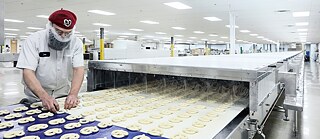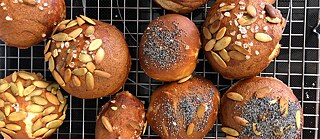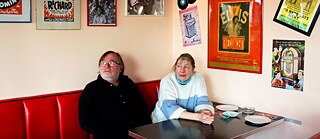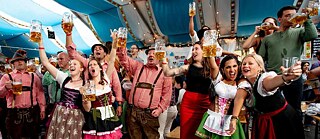A centuries-old history full of myths and stories
The Story of the Brezn
The pretzel — ‘Brezel’ or ‘Brezn’ in German — is not an ordinary pastry. It has a rich history, full of myths and hearsay. Where did it come from? How did a baked good doused in lye become a beloved snack?
This feature was co-produced by Wolfgang Karg and Irene Binal. Wolfgang is a German television and radio producer from Munich, and Irene is an Austrian journalist based in Berlin. In this episode, Wolfgang talks to pretzel bakers from Germany, Switzerland, and the U.S. and visits the pretzel museum in the German state of Baden-Württemberg. The music for this episode was composed and recorded by Axel Schmitt and is used with his permission.
Transcript
[ROCK MUSIC PLAYING]
Barbara Kosler: A pretzel was always something special. It was great when, in school, you had a pretzel for the break — not merely a sandwich, but a pretzel.
Gary Gottenbusch: It has no borders. It has no religion. Everyone loves the pretzel. Even a child who can’t maybe even speak yet could eat a pretzel. They love it.
Isabelle Rohn: I especially like that it’s crunchy on the outside and soft on the inside and that it has that special taste that comes from the washing soda.
Kürsat Bayram: A pretzel is best when it comes fresh from the oven, with butter and chives ... then you can never get enough.
Markus Müller: Many mothers take a pretzel as food for lunch. Or they pick up their children from kindergarten in the evening and on the way home they stop to buy a pretzel.
[NOISES IN CAFÉ]
Wolfgang Karg: A small bakery in the Schöneberg district of the German capital, Berlin. It’s called Pretzel Berlin, and here you can find pretzels in all possible variations. Owner Markus Müller is fascinated by the intertwined pastry.
Markus Müller: For me, a pretzel is something that I can produce in many different forms. I produce 33 different types of pretzels here. It starts with cheese pretzels, pumpkin seed pretzels, pretzels with chili con carne, jalapeno pretzels, cheese and bacon pretzels, pretzels with chives, butter, cream cheese, rocket ... [FADING]
Wolfgang Karg: Markus Müller is a cheerful man with a broad smile. For many years pretzels have been at the center of his life — and not only since he opened his café in Berlin-Schöneberg. Before that, he was managing director at Pretzel Company, an enterprise specializing in producing pretzels. A wonderful job, he says — but still, he is happier in his café.
Markus Müller: Now I have three employees and I’m here every day. If I’m not here, it’s because I’m ill. I have contact with my customers, which is very important for me. I feel the need to be on the front line.
Wolfgang Karg: Markus Müller is still connected to his former enterprise, the Pretzel Company, which recently changed its name to Pretzel-Manufacturer. Müller gets the dough pieces from them and finishes the pretzels in his bakery.
Markus Müller: Pretzel-Manufacturer is just about the only company that can produce so many pretzels. They cater for every soccer game, every big event, every street fair — and I’m rather happy that I don’t have to do that any longer. I can concentrate on my café, I can make sure that we serve the highest quality pretzels, that we don’t have too much stress. And the biggest advantage is that I can bake fresh pretzels every hour.
[MACHINES RUNNING IN THE PRODUCTION HALL]
Wolfgang Karg: The pretzels that Markus Müller sells to his customers are produced in the Berlin district of Neukölln. Here is the production hall of Pretzel-Manufacturer, a company now completely in Turkish hands. But how do Turkish businessmen deal with such a thoroughly German pastry? It just happened, says Kürsat Bayram, one of the managers of Pretzel-Manufacturer.
Kürsat Bayram: We just carried on with it as it always had been. We didn’t change much. It’s business. It was an opportunity, and so we took over the company. And people are very happy. Even our old customers — who have been buying pretzels here for 20 years or more — have told us that it’s just such good luck that we’re here, so things are going well.
Wolfgang Karg: The original pretzel is made from flour, yeast, salt, oil, some special malt, and water. That’s the whole secret. These ingredients are kneaded in a machine called a ‘kneader.’
[KNEADING DOUGH]
Baker: [GERMAN] Hefe, 100 Gramm Salz, Brezelmalz ... [FADING]
Kürsat Bayram: Here we have a device to dose the water. It automatically measures the water and sets the temperature. While kneading the dough, it gradually adds water.
Wolfgang Karg: The pretzel dough is well kneaded. A really simple recipe, says Kürsat Bayram.
Kürsat Bayram: [GERMAN] Das ist alles. Also wirklich sehr simpel.
[ROCK MUSIC PLAYING]
Wolfgang Karg: But even a simple recipe can always be improved. For example, with the help of music. This is what North Bavarian baker and rock musician Axel Schmitt is experimenting with.
[ROCK MUSIC PLAYING]
Axel Schmitt: I’m a musician, and therefore, it was obvious to bring together my two interests: baking and music. Music consists of sound waves — similar to compression waves — and so I thought, it could have some influence on the dough. And then I started researching.
Wolfgang Karg: Axel Schmitt, a fair guy with a goatee, is not merely a baker but a bread sommelier, employing about 50 staff members in his five stores. While working with the dough, he loves to listen to rock-and-roll.
[ROCK MUSIC PLAYING]
Wolfgang Karg: Axel Schmitt found out that this piped music did indeed change the quality of the pretzel dough.
Axel Schmitt: There are big sound waves, humming sounds that you feel in your stomach — and then there are ultrasound waves, that are really tiny and that we cannot even hear. But the dough feels it and on this ultrasound frequency, the dough mixture starts to swing. This leads to changes in the degree of acidity, and the taste will be a little bit different.
Wolfgang Karg: But can you really taste such tiny differences in a pretzel? Yes, says Axel Schmitt.
Axel Schmitt: The dough will become a bit more tasty, a bit more sour. You can regulate the acidity that is responsible for the taste. In general, music regulates the taste and creates small nuances.
[ROCK MUSIC PLAYING TILL THE END]
[MACHINES RUNNING IN THE PRODUCTION HALL]
Wolfgang Karg: In the production hall of Pretzel-Manufacturer in Berlin-Neukölln, the pretzel dough is not musically entertained. After it has been well kneaded, another machine measures the necessary amount of dough — around 100 grams (3,5 ounces) for an average pretzel, Kürsat Bayram explains.
Kürsat Bayram: The dough is taken out of the kneading machine by hand, with a knife, and then the pieces are put into the dough splitting machine. Here we work semi-automatically.
Wolfgang Karg: Piece by piece, the machine splits the dough and throws it out. At this point, it’s just a piece of dough — but now it takes on the typical form of a pretzel. This is also done with the help of a machine.
Kürsat Bayram: The dough falls into this machine, where there is a roller that rolls the dough and makes sure that the ends are flat. And here we see that the vacuum cups take the end of this dough roll and shape it to a pretzel.
Wolfgang Karg: Indeed, one pretzel after the other comes out of the machine. Only from time to time, it does not work properly. Then the baker has to loop it himself.
Kürsat Bayram: He’s very fast. This is the looping, to throw the dough into the air and turn it ... [FADING OUT]
[BLOWING TRUMPETS]
Wolfgang Karg: It’s the form that makes the pretzel so unique, a form that has existed for centuries. Its origins are unknown, but there are many legends about how the form of the pretzel came into being. Bavarian journalist Barbara Kosler has written a book about the pretzel and knows the sagas.
Barbara Kosler: If you ask about today’s pretzel form, there have been lots of assumptions. But there is an especially wonderful story that it comes from monks, who crossed their arms while praying. It looks a bit like a pretzel, and the pretzel comes from regions with many monasteries.
Wolfgang Karg: In the state of Baden-Württemberg in the southwestern part of Germany, there is a whole museum dealing with the pretzel, its history, and its forms of appearance. Director Sonja Hart knows a different story about how the pretzel came into being.
Sonja Hart: Here in Swabia, we have the story of a baker called Frieder, who had mixed something rotten into the flour for his duke. Because of this, he was sentenced to death — but the duke granted him a reprieve: Within three days, he had to invent a pastry that let the sunshine through in three places. And he got the inspiration from the guard and from his wife, because they stood there with their arms crossed — and so these crossed arms, this embrace, was formed into a pretzel.
Wolfgang Karg: Through the centuries, the form of the pretzel has changed again and again. Sometimes it was a ring with crossed ends, sometimes it was triangular or had the form of a heart. Today, the forms of the pretzel are still different in different regions.
Sonja Hart: There is the Swabian pretzel, where the arms are very thin and the belly is a bit bigger and has to be white, so the dough is cut to make the white part show through. In Bavaria, the arms are a bit bigger and the dough is not cut — rather, it springs open after being baked. In the region of Baden, the arms are folded in a different way. In Alsace, very often the arms are not knotted at all, but just placed one above the other. And in the U.S.A., the pretzel is similar to the Bavarian form, with bigger arms.
[BLOWING TRUMPETS]
Wolfgang Karg: Even today there are still intense discussions about the form of the pretzel — and some of them turn out to be real quarrels, as writer Barbara Kosler found out.
Barbara Kosler: Just now there is a patent dispute going on because somebody invented a pretzel form that — unfortunately — already existed 200 years ago. There are so many different forms that it’s really difficult to invent a new one.
[BLOWING TRUMPETS FADING]
[MACHINES RUNNING IN THE PRODUCTION HALL]
Wolfgang Karg: In the production hall of Pretzel-Manufacturer in Berlin, the pretzels already look like pretzels. Now they are on their way into the cooking chamber, as manager Kürsat Bayram explains.
Kürsat Bayram: Some people ferment the dough in a bowl at the very beginning, but here we do it differently. When the dough is formed into a pretzel, it’s fermented in the cooking chamber.
[NOISES OF COOKING CHAMBER]
Kürsat Bayram: The temperature inside is important — it’s a bit like a sauna — and this speeds up the fermentation process.
[MACHINES RUNNING]
Wolfgang Karg: 45 minutes later, the pretzels are fermented. Now it’s time for the most important step of all, which gives the pretzel its unique taste: the application of the lye.
[WHEELS RUNNING]
Kürsat Bayram: The lye is key for the pretzel. All the other steps could be done at home just as well, but the application of the lye is the true art of making pretzels.
Wolfgang Karg: The application of the lye is done automatically to make sure that all pretzels are doused equally.
Kürsat Bayram: The pretzels are placed here on a cloth, the baking tray is taken away, and here you see a liquid. That’s the lye. The goal is to apply the lye equally, and when we push this button here, the cloth is pulled away. On the other side, there’s an empty baking tray and the pretzels doused in lye will be placed on this empty baking tray.
Wolfgang Karg: The lye is the most important ingredient in the whole process of baking pretzels. It makes sure that the pretzels become browned and delicious.
Kürsat Bayram: If you don’t apply the lye then you get just a pale piece of bread — like white bread, looking rather uninteresting. Only the lye guarantees the brownish color.
[ROCK MUSIC PLAYING]
Wolfgang Karg: Lye — also called washing soda, in former days, nothing more than a cleaning agent — and so, very unusual as a baking ingredient. The legend of the baker who had to invent a pastry with three holes to avoid being executed also explains how the lye came into the recipe. As writer Barbara Kosler explains, because the baker was very nervous, a mishap occurred.
Barbara Kosler: He was terribly anxious when he bumped into the baking tray with the freshly baked pastries and they all fell into the washing soda. He started screaming, “Oh my god, it’s all ruined!” But his wife — very down-to-earth, as women are — said, “Put it into the stove again so it will dry there and then we’ll go to the duke’s castle.” That’s what they did, and the duke was absolutely enthusiastic. He tried the pastry and said, “Never have I tasted anything like this before. It’s wonderful!” And so, of course, the baker was not executed and that’s how the pretzel with lye came into being.
Wolfgang Karg: Washing soda on a pastry — that sounds a bit dangerous. But nutritionist Isabelle Rohn from Potsdam University near Berlin can allay these fears.
Isabelle Rohn: In fact, it’s only sodium carbonate, which is not dangerous at all; it’s just a kind of salt. Of course, nobody would drink lye, but the pretzel is only doused in the lye and that gives it the brown color — and has some influence on the taste as well, because the amino acids and the sugar in the dough react with the lye, and result in what are called Maillard-products. So we find these roasting flavors — that we know from a lot of other foodstuffs — also in the pretzel.
Wolfgang Karg: But some pretzels don’t need to be doused in lye. In Northern Bavaria, the home of musical baker Axel Schmitt, a special variation of the pretzel is very common.
[ROCK MUSIC PLAYING]
Axel Schmitt: It’s called salted pretzel, without any lye. It’s not as brown as other pretzels, but rather has the golden color of a baguette. It’s sprinkled with fine salt, not coarse salt, and it tasted a bit milder.
Wolfgang Karg: But for the classical pretzel, lye is as necessary as flour or salt or yeast. An average pretzel has about 200 to 250 calories, significantly less than a hamburger from a fast food chain. From a nutritionist’s point of view, a pretzel clearly outperforms a hamburger, says Isabelle Rohn.
Isabelle Rohn: Compared to a burger, a pretzel has a lot less grease. So you cannot call it junk food, though there are lots of healthier pastry variations. It can’t compete with a whole grain bread, but compared to a burger, it’s the better alternative.
Wolfgang Karg: But what happens inside our body when we eat a pretzel? Most of all, the level of blood sugar goes up.
Isabelle Rohn: The reason is the flour in the pretzel. Flour is rich in starch, and the enzymes break down the starch. That starts in the mouth. When you chew on a pretzel you will suddenly notice a sweet taste, like with a normal white bread — and then the glucose will go into your blood very fast, which gives you an energy boost.
Wolfgang Karg: Good for those who need fast energy. A pretzel eaten before an exam can be quite helpful. Athletes can benefit from a pretzel sprinkled with salt to balance the loss of salt while sweating. And even sick people can eat a pretzel without hesitation.
Isabelle Rohn: If you catch the flu, people tell you to eat salty sticks, but a pretzel would be just as helpful because it has the same characteristics. The flu sufferer loses liquids and salt, and salt has to be replenished.
Wolfgang Karg: Sure enough, real fans of the pretzel — like Bavarian writer and journalist Barbara Kosler — don’t care if the pretzel is healthy or not.
Barbara Kosler: I eat something because I like it. If it’s healthy as well — fine, but if it’s only healthy but tastes horrible, nobody could persuade me to eat it. For me, that makes no sense.
[ROCK MUSIC PLAYING]
[MACHINES RUNNING IN THE PRODUCTION HALL]
Wolfgang Karg: In the production hall of Pretzel-Manufacturer, all the pretzels have been equally doused in lye. Now they have to be sprinkled with toppings, explains Manager Kürsat Bayram.
Kürsat Bayram: Here we have salt, cheese, pumpkin seed ... depending on what we want to sprinkle on the pretzels. For pretzels with large-grained salt or pumpkin seed, we don’t sprinkle them but press the seed or the salt into the dough.
Wolfgang Karg: And now it’s getting hot: The pretzels will go into the oven for 10 minutes at a temperature of 240 degrees Celsius — that’s 464 degrees Fahrenheit.
[TRAYS PLACED IN OVEN]
Kürsat Bayram: We cover them with another baking tray in order to keep the upper row from burning in the heat.
[BLOWING TRUMPETS]
Wolfgang Karg: Today, the pretzel is mostly just a quick snack. But in former days, the pretzel was seen as something magical, it was part not only of the sign of the baker’s guild, but also of traditional customs in Southern Germany, as journalist Barbara Kosler explains.
Barbara Kosler: In the old days, a woman who had given birth to a child would get a pretzel, and children got a pretzel on their first day at school. On some special days, a young man would place a pretzel on the windowsill of their beloved, and as long as the pretzel did not mold, the girl was faithful to him. And if a young man wanted to take out a girl to dance, he would present the girl’s mother with a string of pretzels to secure the date.
Wolfgang Karg: Pretzels were not just any pastry; they were seen as something special. During the fasting period, they were given to the old and infirm. At banquets, they were served as a sign of friendship. Even today, they play an important role at Carnival in Southern Germany. Sonja Hart, director of the Pretzel Museum in Baden-Württemberg:
Sonja Hart: In Southern Germany, they still have the custom of giving away pretzels during Carnival. People have long sticks with pretzels on them and they present them to the audience. There is also an element of worship in this custom. It’s about driving out the winter and also includes a form of reverence to the Lord.
Wolfgang Karg: Musical baker Axel Schmitt from Northern Bavaria remembers his childhood when a pretzel was not just an everyday pastry.
Axel Schmitt: It was a pastry for New Year’s, baked to honor the New Year. Later it was served on weekends. In my childhood, a pretzel was part of the typical weekend breakfast. And it was the same in the whole town: Every Saturday, people would eat salted pretzels and sausages.
[BLOWING TRUMPETS]
[MACHINES RUNNING IN THE PRODUCTION HALL]
Wolfgang Karg: In the production hall of Pretzel-Manufacturer in Berlin, the pretzels have been browned in the oven. Now, it’s time to get them out.
[TRAYS TAKEN OUT OF THE OVEN]
Wolfgang Karg: Manager Kürsat Bayram is completely satisfied. This, he says, is the way perfect pretzels must be: perfectly browned.
Kürsat Bayram: [German] Das ist die perfekte Brezel. Die Bräune ist super.
Wolfgang Karg: A unique pastry, especially for Kürsat Bayram, who has Turkish roots. In Turkey, he says, the pretzel is not common.
Kürsat Bayram: We know rings with sesame, called Simit, and the Turks often call the pretzel ‘the German simit,’ but there is nothing like the pretzel in Turkey.
[ROCK MUSIC PLAYING]
Wolfgang Karg: Turkey is one of only a few countries that hasn’t adopted the pretzel yet. The intertwined pastry is popular all over the world. If people don’t find it in a bakery, they might at least know it from old paintings, as the director of the Pretzel Museum, Sonja Hart, explains.
Sonja Hart: If you consider that the pretzel has been the sign of the baker’s guild for more than 700 years, and if you keep in mind that wall paintings or wall ornaments often feature a pretzel, then it’s no wonder that the pretzel is so common internationally.
Wolfgang Karg: This international interest in pretzels is especially good for big enterprises, like Swiss company group Valora. In 2012, Valora took over German pretzel bakery Ditsch, based in the city of Mainz in the German state of Rhineland-Palatinate. Now Ditsch produces 120 million pretzels a year, due to heavy demand, explains Swiss Ditsch Manager Thomas Eisele.
Thomas Eisele: The interest in pretzels is growing in Europe, in Asia. In Japan, for example, Tokyo has the third-largest Oktoberfest in the world and the pretzel is always associated with the Oktoberfest. It is also taking hold in China. In Shanghai, it’s now regarded as ethnic food, so it’s still a small niche, but it’s obvious that the interest in pretzels is growing internationally.
Wolfgang Karg: Ditsch is also represented in the United States, as it took over the baker Pretzel Baron from Cincinnati in Ohio. Its general manager Gary Gottenbusch is a huge fan of the pretzel.
Gary Gottenbusch: One of my first memories of the pretzel was when I was a child holding a pretzel. And I just remember the joy of holding a pretzel and — I don’t know why — it’s slippery in your mouth, the salt. At the time, it was very cool, was emotional for me to go back to it.
Wolfgang Karg: Gary Gottenbusch successfully completed an apprenticeship as a baker in Germany where he learned how to form a pretzel.
Gary Gottenbusch: My master showed me the first twisted pretzel. He threw it up in the air and he actually connected it in the air and brought it down. It was just a shock to me: how did he do that? It was like magic. So I decided that I was gonna learn how to make a pretzel. And then actually looking at the Ditsch stores here in Germany, at the train stations, the high traffic locations. The smell of fresh-baked pretzels when they walked out of you know — on a busy day going somewhere. You don’t have time to stop and then you have time to stop to get a pretzel.
Wolfgang Karg: The pretzel that is most common in the United States is similar to the Bavarian pretzel, with slightly bigger arms. But there are many, many variations, due to state and region.
Gary Gottenbusch: On the West coast, they have a lot of cinnamon sugar products, maybe it’s the demographic — but still regional. On the East Coast, people prefer buying a salted pretzel on the street corner. And I was in North Carolina actually and somebody served me a pretzel from a deep fat fryer. And I was shocked. I looked at it and said, “Why would you put it into a fryer?” And the guy said, “Son, down here, if you fry it, they buy it.”
[ROCK MUSIC PLAYING]
Wolfgang Karg: In the United States, in Europe or in the Far East, in the North and in the South — the pretzel is experiencing a triumphal moment. Children and adults love them, as do vegetarians and vegans. Though vegans have to be a bit careful, as nutritionist Isabelle Rohn from Potsdam University explains.
Isabelle Rohn: Sometimes, bakers add lard or butter to the dough to make it smoother. And then the pretzel is not vegan anymore, because of the animal fats. The pretzel is not automatically suitable for vegans.
Wolfgang Karg: At company celebrations, soccer games, or street fairs: the pretzel is everywhere, brown and crunchy with intertwined arms. There are endless possibilities for experimenting, as Berlin baker Markus Müller knows.
Markus Müller: Sometimes I have pretzels with chicken curry and pineapples or sweet pretzels with Nutella or with cinnamon and sugar. You can do everything with the pretzel. It goes with almost every kind of food — that’s the wonderful thing about it.
Wolfgang Karg: Because in the end, it’s all about taste. And the taste is way beyond compare, says American baker Gary Gottenbusch.
Gary Gottenbusch: It’s a different mouth feel. It’s a different experience. You have the snap of the arms of the pretzel, and then you have the soft belly of the pretzel. It’s not like eating a bagel. It’s not boring or white bread, it’s fun food. It’s a simple food at the same time. But the twist even makes it look more complicated.
[ROCK MUSIC PLAYING]







